|
|
| home > files |
| NL
Architects interview - 1 Daniele Mancini |
| PROJECTS
& THEME |
||||
| [in italiano] | DANIELE
MANCINI: I would like to start this conversation from the end, talking
about your most recent projects and realizations. Especially I want
to orient the discourse on what we can call functional and typological
'unexpectedness'. In regard to your designs, you say 'often projects
focus on ordinary aspects of everyday life, including the unappreciated
or negative, that are enhanced or twisted in order to bring to the fore
the unexpected potential of the things that surround us.' Could
you illustrate this position with some of your projects? NL ARCHITECTS: First of all I think the context of this mentality is important. The generations before us used to have a 'critical' attitude towards life: preconception based on ideology. Banality was freighting, popular culture a threat. There was a strong believe that 'society could be made'. The general tactics were to exclude what was considered negative from any form of design. Undesired aspects of life, like consumerism, 'the market', the masses, and auto mobility were not taken into account. The solution is not necessarily to fully embrace these phenomena, but to accept the fact they exist, to be empirical and to look for ways to channel them. In the nineties Ideology was replaced with pragmatism and this created an enormous freedom and flexibility. 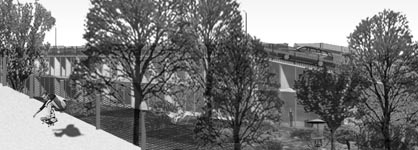 In respect to the position of the car the dominant idea was that its use should be discouraged. But despite oppressive measures and limiting regulations, the numbers of cars kept on growing. A discrepancy emerged between the situation that was desired and what was actually happening. A judgmental attitude blocks an open view. As a consequence the position of the car was never resolved. In 1994 we asked ourselves the question: can parking garages be made beautiful? To illustrate our way of thinking we presented Paid Parking, or MAZDA parking. If you park in a configuration in the shape of a logo, parking could become more attractive: one would receive four Euro an hour. This could help to rethink the whole issue. Our project Ornament und Verbrechen, (Ornament and Crime) could serve as a 'logo' for this approach. This project was a byproduct of the initial design phase of the Heat Transfer Station in Utrecht. When we started thinking about WOS 8 no site was available yet. But the time pressure was such that we should start designing anyways. We looked at similar buildings and saw they were all victim of vandalism. They were sprayed under graffiti, set fire to etc. It made us think about Adolf Loos a lot: "The man of our day who, in response to an inner urge, smears the wall with erotic symbols is a criminal or a degenerate. A country's culture can be assessed by the extent to which its lavatory walls are smeared. The evolution of culture is synonymous with the removal of ornament from utilitarian objects. I believed that with this discovery I was bringing joy to the world; it has not thanked me. People were sad and hung their heads. What depressed them was the realization that they could produce no new ornaments. Are we alone, the people of the nineteenth century, supposed to be unable to do what any Negro, all the races and periods before us have been able to do? We have outgrown ornament; we fought our way through to freedom from ornament. Soon the streets of the city will glisten like white walls. The modern man who holds ornament sacred as a sign of the artistic super-abundance of past ages will immediately recognize the tortured, strained, and morbid quality of modern ornaments.. 'Ornament and Crime' puts the hardware deployed to protect property from victimization to a fundamental use. We discovered an unbelievable arsenal of protection devices: Cobra-Spikes, Rotating Spike-Combs, glass splinters, Super-Spikes and Barbed Wire in seemingly endless variations. Could we turn these usually unappreciated 'needles and pins' into a form of functional decoration? The hypothesis was that through intensification a certain beauty could be reached. Paradoxically, when our client finally found a site (not in my backyard!), it turned out to be far from urban. The building now was projected in the backyard of a farm, the only possible threat a mad cow. So we had to rethink our starting point. That is why WOS 8 is slightly reminiscent of a shed. Or the kind of heap that farmers use to preserve grass for cows to eat in winter. This is why WOS 8 is black. But in few years the surrounding meadows will be developed into a residential area and the building will become a tactile part of the public domain. Instead of heavily protecting it, as we started out doing with the Ornament und Verbrechen proposal, we decided to open it up, to expose it. We aimed at making it a fundamental part of the youth culture that is usually the biggest threat for it. Maybe that would work too. 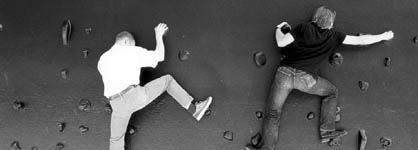 In a way WOS 8 is a public square wrapped around a box. A series of climbing grips are inserted under the Polyurethane skin, since, believe it or not, climbing has become a national sport in the Netherlands. Applied in Braille, they spell a text (that I won't reveal here, I'm sorry!). By using the unbreakable, transparent backboard as the only source of daylight, a window game into being at which you should through a ball. Presenting yourselves, you say: "NL's 'commuting' first office, a blue-metallic Ford Escort Station, started while carpooling between these cities [Delft and Amsterdam] (in that sense the principals like to think of themselves as autodidactic; the recurrent fascination with mobility and tarmac perhaps could be traced back to being 'educated' on the highway)". Could you be more explicit? Could you show how your projects are interpreters of this fascination? We were studying in Delft and living in Amsterdam, a distance of about one hour. So we were condemned to each other in the confined space of the car. And we were discussing architecture a lot. The car became the pressure cooker for our early ideas. And hanging out on the Highway made us susceptible to its beauty. [...] Early nineties we proposed several projects exploring qualities of infrastructure related elements. We imagined illuminating roof gardens of road reflectors combined with the florescent paint used in demarcation or the sculptural potential of crash barriers to clad buildings in. One of my personal favorites is still Anyhall in which we had fantasies about combining truckers' culture, highway aesthetics and pornography. Anyhall is a proposal for a distribution center. The front facade is made of red roadside reflectors, the size of a regular brick, resulting in an immense taillight in the landscape. The shed in-between is clad in absorbing, black EPDM rubber. This type of reflector throws back the light exactly in the direction you sent it. If the angle of incidence is less than 30 degrees the reflector becomes transparent. So information that is mounted under the skin becomes available: the playmate of the month appears. (If you want to have a good look and you switch on your headlights, be careful, she might blind you!) In order to be able to zap across the facade the access road is molded into a 3D surface. Since this linear and limiting element expands into a field, the trajectory becomes individual: a new type of road. 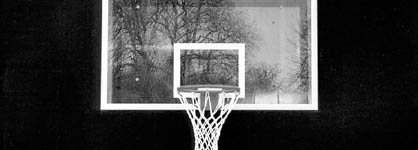 [...] Since you don't seem very much obsessed by the usual contemporary approaches like the program or the cognitive and thematic maps of activities, the flows of perception and use, how do you place yourselves within the culture of Dutch architecture? Which is your territory? I think basically it is the capacity to compress banality into 'meaning'. To add affection to commonness until it transforms into something unexpected. And to fuse specific clients wishes with public interest. We hope to contribute to an understanding of the timeframe in which we operate. What is out there and how can we make it better? On the basis of careful observation we aspire to come to a radical conclusion. Before going to Delft University Pieter was studying for two years at the Rietveld Academy (the main art school in the Netherlands). His sculpture teacher at that time set an assignment to compose three objects that should rest on three points only. At the day of the hand-in Pieter walked up to her and crumpled a piece of paper and threw it on her desk. And then another one. After the third he was expelled from the school! Even though all paper pellets were unique and all were perfect tripods. A seemingly careless act that was considered offensive but that actually was a precise answer to the brief. Of course we are very much involved with the 'program'. It only happens to be hard to evoke programmatic change or innovation. We consider it our core business to rethink typologies, but it seems to be in the hands of the developer or clients. Only now and then we succeed, like with the BasketBar where we managed to extent the public space onto the roof. [...] |
[19oct2003]
|
||
| CITY One of the biggest discussions today is on 'urban condition'. As architects you see how the radical change of our contemporary society (migration, medialization, individualization, and globalization), affect the urban development models and modify deeply the architectural process. By your point of view, what is the meaning of this debate, and how does it relate to your work? I live in Amsterdam, in a boring street. In this average street is a daycare center. Next to the daycare center is a whorehouse with window prostitution (semi naked ladies in the typically Dutch XL windows). This unimaginable collage leaves its marks on how you think about the city. [...]  Demographic developments play an important role, in politics -because we have to make some choices- but in planning too. The ageing of the population will have deep impact, especially in the EU. If we don't Fuck For Future as Bjorn Borg suggests we will either end up with a shrinking population (one quarter of the urban substance might turn into wasteland!) and a collapsing pension system or we have to seriously open our borders. Both will have profound consequences for our cities. It has been calculated that the European Union, with a population of 370 million today, will need 700 million immigrants between 1995 and 2050 to maintain the Potential Support Ratio (the rate of working age population to retired or the dependency rate) on the same level of 4,4 as in 1995. These figures are insane and they indicate the severity of the issue. (At the same time they reveal the origin of the (economic) success of the nineties). Mobility has increased to such an extent, that it even influences the way we think about our last 'resting place', the cemetery. In the old days it was evident that the burial ground would be within walking distance of where one lived. Now constant migration made us 100% footloose. The question of where to imagine ones grave becomes increasingly difficult to answer. As a consequence many people became indifferent about their final destination. We recently made a proposal for a multilevel graveyard, the Sky Cemetery NT that explores the possibilities of the accumulating benefits of a super large cemetery. After a certain critical mass it will become an attraction and potentially an expanding reservoir of information. It could become a sort of database for the collective memory. The central question in the so-called Architectuur Nota (the Architecture Policy of the Netherlands for the coming years) is if the government will be able to bring to a halt what is described as 'the country getting messy'. The country that used to appear so fresh and so clean, with such a rich planning tradition and so perfectly organized is developing into a chaotic patchwork of disconnected enclaves. Planning seems out of control. It is typical for this country that it is a concern in the first place, something to be worried about, or to develop strategies for channeling it. Much of the aggravation is caused by what is visible from the highways. Here, extensive cheap urban substance is produced; distribution centers, office buildings, showrooms, car dealers etc fight for a spot in the front row. The pastoral artificial landscape disappears under a crust of low cost shelter and glossy accommodation, the Business Areas. The 5th Bill on spatial planning claims that before 2030 at least 50.000 hectare will be necessary to accommodate new Businesses in the Netherlands. A 'point city' with a diameter of 25.2 km. It will take you 15 minutes to cross this City if you fix the cruise control at 100 km/h. But of course the new business areas won't be designed as one coherent cluster; they will be scattered all over the place. At least 250 new sites are projected. But not just by numbers the issue of Business locations is of great importance for how the country looks. Where the housing program disappears behind noise barriers, buffers, sound screens, obligatory minimum distances and banks and borders, these requirements don't apply to office buildings and warehouses. As a consequence they are much more in the face, exactly where they want to be. If we assume all 50.000 Hectare of new business areas will be constructed along the highways, as the 'market' demands, this will result in a 100 meter wide crust on both sides of the road. The country will appear 'full' since the Highways became the dominant medium in the perception of the condition Holland is in. "To each hamlet its' own periphery" (Rem Koolhaas). At this moment small business areas emerge everywhere. And they are all the same. And they are boring. Nevertheless already 50% of the working population is active in these areas! Clustering and de-fragmentation is the answer to end the sprawl of endlessly repeated similar low quality clusters and solutions. Larger areas by definition are more interesting then the current mediocrity; after a certain critical mass additional services become feasible and quality rises. Daycare center, shop, hairdresser, public transport. What is the minimum size of a business park to at least accommodate one drive-in MC Donald's? By law the smell of freshly baked bread is considered stench. Bakeries are removed from residential zones; they are banned to business areas. Regulations become so abundant that segregation between the different functions that build up the city is inevitable. The City becomes mono-functional. Architects and planners are in despair. They are not willing to accept this oil and vinegar urbanism. The amazing thing is however that the lack of mixture might be the key to more uplifting and exciting business areas. All programs that are cast out from what used to be called the city constitute new potential for these areas. The Power Zone, the hottest dance club in Amsterdam (opened 24-7, accommodating 5000 people), is located in a business area flanked by a Home Depot and a Carpetland. Periphery becomes Center. Squeezing the life out of cities might reanimate the desolate working environments. We talk of global cities, emerging cities, edge-cities, metapolis; we use expression like sprawl cities, hybrid landscape, urban edges, generic cities; E. Soja spoke of the "spatial turn" and of the "third space" in regard to the phenomena of the 90's. How do you place yourselves in front of contemporary urban phenomena? Are you interested in Rotterdam, New York, Roma, Paris, Tokyo, Shanghais, Bangkok all in the same way? Edge Cities, Urban Villages, Outtowns, Suburban Downtowns, Suburban Activity Centers, Major Diversified Centers, Urban Cores, Megalopolis, Pepperoni-pizza Cities, A City Of Realms, Superburbia Disurbs, Nonplace Service Cities, Perimeter Cities, Spreadcities, Peripheral Centers, Tomorrowland, Galactic Cities, Urban Field Exurbs, Polynucleated Cities, Technoburbs, "the Burbs", Conurbations, Mallopolis, Slurb, Sprawl. While working on our thesis project we were concerned about the traditional center. Could we prevent the historic city to be reduced to theme park or museum? Could we revitalize it, find ways to reanimate it, prepare it for the next century? 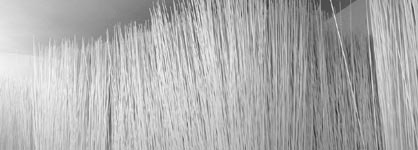 According to Dutch law it is forbidden to demolish monuments. But we discovered that if carefully taken apart, it is allowed to re-construct historical buildings elsewhere! This small gap in the law can have great implications. Where necessary, areas in the historic center can be cleared of monuments in order to establish a new condition; a kind of tabula rasa can be created. Space for large-scale developments becomes imaginable. And, surprisingly enough, at the same time in other areas Densification of Monuments© is a possibility too! So one can even intensify the Historical. But of course Amsterdam is considered finished, like Venice. No alterations are imaginable. This is particularly funny since in the 17th century –when large parts of the city were constructed- nostalgia was considered a disease, a disease that had to be cured by medical intervention. But in some eras there was progress. Hendrick de Keyser (1565 - 1621) has build 11 church towers during his (short) life. He designed every structure exceeding the average height: one man single handedly constructed the entire 'skyline' of Amsterdam. This allows for a form of optimism. |
||||
| OFFICE
& 'METHOD' OF WORK |
||||
| When
I was in Amsterdam last November, I found your office very bright and
comfortable: could you spend few words to explain how your office is
organized? How many people are in your team? Where do they come from?
Where is located? Why did you choose that location? Why did you choose
Amsterdam? Is Amsterdam a good place to start a professional practice?
Have you never thought to open your office somewhere else? Milano, London,
New York, Rotterdam? In spite or maybe because of our name people from all over the place apply for jobs at our office, but strangely enough not many are Dutch. So we have always worked with a lot of foreigners; the language in the office is English. The workforce changes a lot in size and composition depending on the 'economic climate'. In the beginning of the Millennium we were optimistic about growth. We were involved in a number of projects of considerable size and complexity. But somehow things did not develop in the way we imagined. Many projects stagnated -for various reasons- and we had to adjust our expectations. [...] The office has always consisted of 4 partners; a boy band. On average we have three staff members and several interns. So we are a compact practice. I like to think of the office as a 'horizontal' organization, in which employees might encounter a lot of freedom. During the design process everybody is encouraged to produce ideas and solutions. It is a brainstorm in which the most promising ideas are further developed. Of coarse we have a final say. But since there are four of us, the staff can play us out to influence decisions. How did you get your first job? How does it come that you are engaged for a job? Which difficulties did you face at the beginning? Which is the situation at moment? Do you feel lucky/unlucky? Since we opened our studio already during our studies we started out with all kinds of mini-projects, from kitchen to bathroom and roof extension. Through a friend of the family we got to do the interior cinema. But in 1996 it was Rients Dijkstra of Maxwan who offered us the possibility to construct our first 'real' building: WOS 8. He was masterplanning Leidsche Rijn, the city expansion of Utrecht. For this new city a 'central heating system' was planned, and a small building was needed as a node in the network. Normally this kind of purely technical building is a blind spot in urbanism. But Rients set the ambition level ultra high. The energy company, our client, was interested in working with us because we potentially could cater for a smooth handling of the procedures. Since we were pushed forward by the so-called 'planning bureau' the client hoped we could produce a solution that would please the authorities. It is fascinating to realize that much discussed 'beauty police' played a crucial role in this process. This beauty committee brings out an advice to major and aldermen and is as such relatively powerful. Many architects advocate the elimination this paternalizing organization. But in spite of the sometimes humiliating situations, apparently it can be the incentive for 'higher-level' architecture. If the aesthetics committee had not been an instrument of planning WOS 8 would never have been built! Per ottenere commissioni, è cruciale avere qualche supporter influente. Frits van Dongen ci ha permesso di progettare un blocco nel suo master plan per l'area Funen ad Amsterdam. Attraverso il suo potente entusiasmo il developer è stato convinto. For obtaining commissions it is crucial to have some influential supporters. Frits van Dongen of Architecten Cie allowed us to design a block in his master plan for the Funen area in Amsterdam. Through his powerful enthusiasm the developer could be convinced. But more and more we discover that the people that we went to school with are finding themselves in powerful positions. And even the generation after us starts to play a role. This helps a lot to get things done. Educational institutes should point out that someday the network that you start building up there will be the most important tool in your development. It is somehow frustrating that the resistance against your work or the skepticism about it is disappearing just by the accumulating power of our generation. 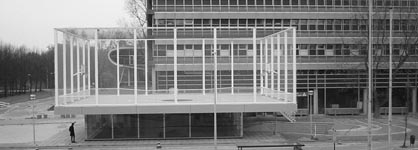 For a starting office like ours it is crucial to actually construct one medium scale project to build-up confidence at the side of potential clients. But so far the projects that could produce the evidence of our skills as an architect are cancelled or on hold. We have to be patient. And we have to go to the gym a lot; as an architect seems inevitable to work on expansion of your life expectancy. Even in this respect Koolhaas can be considered a visionary! It is amazing to see how quickly ideas about housing develop and change. Since there are so many parameters involved in the production of dwellings –clients' demands, economy, ecology, construction methods, regulations, rules, fashion- only one has to progress to result in a radical mutation. By the time you complete your definitive design that is developed on the basis of a certain program of demands and a number of givens at that time the circumstances might have changed completely. If you rework your proposal into a new design and you hand in the contract drawings you might face a new reality again. Back to the drawing board! In the Netherlands where planning plays an important role and many big scale projects are developed time becomes an enemy. These lengthy processes are vulnerable to changes. As soon as the market changes investors start to panic. This more and more turns out to be a serious bug. You can find yourself caught in a loop: perpetually redesigning one single housing block for the rest of your life but never really building it! During my staying at Wiel Arets last year, I had the chance to see with my eyes how offices like Mecanoo, UN Studio, MVRDV etc, develop and present their projects. I was quite impressed by the fact that everyone works massively with models and maquettes, less with hyperrealist renderings and at all with sketches and drawings. Could tell me how you approach a design issue? Which is your 'method'? Do you have a 'method'? How do you start? And how do you develop the project? Which tools do you use? You make models, don't you? And what you can say about the value of the sketches? Do you use computers? Which system, MAC or Win? When does the PC start to be part of your design process? When we had to send in a model for the 9+1 exhibition in 1997 we found ourselves empty handed. We found out that our output was mainly 2D or virtual 3D. We did not have a suitable physical thing to place in the Perspex box. So we decided to create a small object for the occasion. The Ring Roads -a silver jewelry collection based on highway crossings- came into being. They were displayed in a kind of incubator. Since touch is left out from the sensory experiences of window-shopping we felt we should rethink the shop window. Now you could not only look at them but also touch them: the next level in seduction. Since the 9+1 models were presented in 10 big inflatables a strange side effect of our contribution was the fact that as soon as someone was checking a ring the Bubbly Display started to bounce, the architecture became literary animated. [...] In our practise the use of the computer for the generation of shape is less important than the effects it has for communication. Photoshop rules! It is such a powerful tool to visualize ideas. If you don't build it you can fake it! And producing ideas is our core business. In general the computer makes designing much more fun. Precision, beauty, flexibility, seduction, complexity, calculation. Copy Paste. Blur smooth revolve extrude. Without Word I could not write this text. And since I use 3D modeling even my hand sketches got more convincing too! But more and more we like to use 'real' models. There is nothing more effective to judge a spatial proposal than a physical thing that you can hold in your hand or walk around, or stick your head in. Of course with the prospect of direct 3D plotting a totally new condition will emerge. The most exciting building in the Netherlands at this moment is the bus stop by Maurice Nio (the Oni): foam cut by computer and coated with polyester. A seamless process much more refined than the archaic production of our black rubber WOS 8 (which bottom line still is a Portuguese holiday villa). Here the true potential of mass customization starts to be tangible. Our design process is not so much a method; we don't have a fixed recipe. There is a large variety of procedures. In general we start analyzing the question and the location. Then a 'bombardment' starts: a brainstorm with a team of designers. A mix of analysis and intuition. From this a number of options is produced. These are then fired at the 'customer' to check reaction and to absorb feedback. From this we distil a better notion of the question and we start designing more focused. It is surprising how different these processes work. Sometimes it is an endless struggle to find a rewarding answer and sometimes this happens in an instant. (1. to be continued) |
||||
|
Interview made by Daniele Mancini in May 2003-January 2004. All rights reserved: Daniele Mancini and NL Architects (Pieter Bannenberg, Walter van Dijk, Kamiel Klaasse and Mark Linnemann), 2003. A paper edition of the same interview will be soon released by Spazio Architettura magazine. |
||||
|
>
MANCINI: NL ARCHITECTS INTERVIEW - 2 |
||||